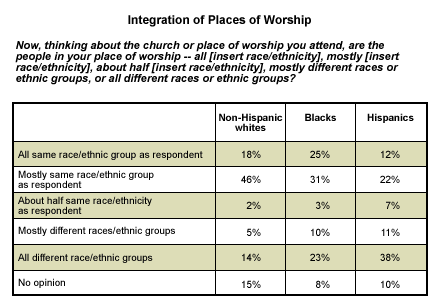First in a two-part series on the makeup of congregations
Much has been written about the tendency for whites to worship primarily with other whites and blacks to worship mostly with other blacks. But a new ║┌┴¤═° Poll* indicates this type of religious segregation does not hold true for Hispanics.
While 64% of non-Hispanic whites worship in congregations that are all or mostly white and 56% of blacks worship in congregations that are all or mostly black, only 34% of Hispanics worship in congregations that are mostly or all Hispanic. In fact, nearly half (49%) of Hispanics worship in congregations that are mostly or all non-Hispanic. In comparison, only 19% of whites and 33% of blacks worship in congregations where the racial makeup is predominantly different from themselves.

Why these notable differences in the worship patterns of whites, blacks, and Hispanics? And what implications do the respective integration levels of their congregations have for their ability to impact members' lives moving forward?
First, I see three primary reasons for the differences: the history of slavery and segregation in the United States, immigration and assimilation patterns, and differences between Protestants and Catholics.
Slavery and Segregation
During the early 19th century, several Protestant denominations split over the issue of slavery. In 1844, the conflict came to a head in the Methodist Episcopal Church -- then the nation's largest denomination. When a Southern bishop married a woman who owned slaves, the Northern churches demanded he be removed from office. Southern churches responded by forming their own denomination, the Methodist Episcopal Church South -- a division that lasted until 1939.
Slavery also spurred the formation of several black denominations, most notably the African Methodist Episcopal Church and the Christian Methodist Episcopal Church, both of which continue to the present day. During the civil rights movement of the 1950s and 1960s, pastors of black churches provided much of the leadership -- Martin Luther King, Jr., Jesse Jackson, and Andrew Young among them.
Throughout that period, some white separatists tried to use religion as justification for segregation. In 1962, ║┌┴¤═° presented respondents with the following question: "Some people say that there is basis in the Bible for segregation -- that is, for keeping the Negro and white races separate. Others say there is no such basis. How do you feel -- do you think there is basis for segregation in the Bible, or not?" About one in seven respondents (14%) said yes, they thought there was a biblical basis for segregation; about half (49%) said no, while 37% had no opinion.
And whether one lived through it or saw the photo in history books, who can forget the image of Southern white pastors standing on the steps of their church, barring blacks from entering? In a landmark study of roughly 1,000 blacks conducted in 1969, ║┌┴¤═° asked respondents whether they thought white churches have been more helpful or harmful to black rights. Just 39% said "more helpful"; 21% thought white churches had done more harm than good, while 41% weren't sure. The scars of America's institutional racism run profoundly deep, and the wounds will take a long time to heal -- a reality reflected in the racially divided church.
Immigration and Assimilation
The evolution of the Hispanics as an ethnic minority in America has been different from that of blacks. For the most part, Hispanics have come to this country not on slave boats but in search of a better life, either as European explorers of the New World, or more recently, migrating from South and Central America. It seems only logical that people who come to a new country by choice are more likely to want to assimilate into the dominant culture than those who are forced to a new country against their will. Assimilation includes congregational membership, and the fact that there has never been a formal, systemic exclusion of Hispanics from the church (as there has been for blacks) is an important difference.
Next week, I'll examine differences between Protestants and Catholics and how these differences affect congregational membership among whites, blacks, and Hispanics. I'll also look to what the future may hold for issues of race and ethnicity in the church.
*The results are based on telephone interviews with a national sample of 2,250 adults, aged 18 and older, conducted June 9-30, 2004. For results based on this sample, one can say with 95% confidence that the maximum margin of sampling error is ±5 percentage points. In addition to sampling error, question wording and practical difficulties in conducting surveys can introduce error or bias into the findings of public opinion polls.
For results based on the sample of 816 non-Hispanic whites, aged 18 and older, the maximum margin of sampling error is ±6 percentage points.
For results based on the sample of 801 blacks, the maximum margin of sampling error is ±8 percentage points.
For results based on the sample of 503 Hispanics, the maximum margin of sampling error is ±8 percentage points. (164 out of the 503 interviews with Hispanics were conducted in Spanish.)
